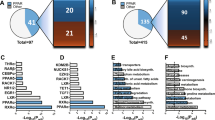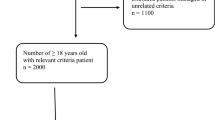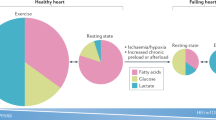Abstract
Genetic factors, alone or in interaction with components of the diet, are thought to be involved in the development of the metabolic syndrome. The objective of our study was first to compare the frequency of the peroxisome proliferator-activated receptor (PPAR)α-L162V polymorphism in a sample of men with and without the metabolic syndrome as defined by the National Cholesterol Education Program-Adult Treatment Panel III (NCEP-ATPIII) guidelines, and secondly, to evaluate gene–diet interaction effects on features of the metabolic syndrome. The PPARα-L162V genotype was determined in a sample of 632 men by a polymerase chain reaction–restriction length polymorphism (PCR–RFLP)-based method; fat as well as saturated fat intakes were evaluated by a dietitian-administered food frequency questionnaire. The frequency of the V162 allele was similar in men with (n=281) and without (n=351) the metabolic syndrome (χ 2=0.03, p=0.84) but was higher in subjects having simultaneously abdominal obesity, hypertriglyceridemia, and low high-density lipoprotein cholesterol (HDL-C) levels (χ 2=3.73, p=0.05). Carriers of the V162 were characterized by higher plasma apolipoprotein B and triglyceride (TG) levels (p=0.10, p=0.004). In a model including the PPARα-L162V polymorphism, fat or saturated fat, its interaction, and covariates (smoking habits, and energy and alcohol intake), the interaction explained a significant percentage of the variance observed in waist circumference (p<0.05). In conclusion, the PPARα-L162V polymorphism alone or in interaction with dietary fat intake is associated with components of the metabolic syndrome.
Similar content being viewed by others
Log in or create a free account to read this content
Gain free access to this article, as well as selected content from this journal and more on nature.com
or
Abbreviations
- NCEP-ATPIII:
-
National Cholesterol Education Program-Adult Treatment Panel III
- PPARs:
-
Peroxisome proliferator-activated receptors
- RXR:
-
Retinoid X receptor
- PPRE:
-
Peroxisome proliferator response element
- Apo B:
-
Apoprotein B
- PCR–RFLP:
-
Polymerase chain reaction–restriction length polymorphism
- L-FABP:
-
Liver fatty acid-binding proteins
- FATP-1:
-
Fatty acid-transport protein-1
- AOX:
-
Liver acyl-CoA oxidase
- CPT:
-
Carnitine palmitoyltransferase
- LPL:
-
Lipoprotein lipase
- SR-BI:
-
Scavenger receptor class B type I
References
American Heart Association (2002) Heart disease and stroke statistics—2003 update. Online: http://www.americanheart.org
Aoyama T, Peters JM, Iritani N, Nakajima T, Furihata K, Hashimoto T, Gonzalez FJ (1998) Altered constitutive expression of fatty acid-metabolizing enzymes in mice lacking the peroxisome proliferator-activated receptor alpha (PPARalpha). J Biol Chem 273:5678–5684
Auboeuf D, Rieusset J, Fajas L, Vallier P, Frering V, Riou JP, Staels B, Auwerx J, Laville M, Vidal H (1997) Tissue distribution and quantification of the expression of mRNAs of peroxisome proliferator-activated receptors and liver X receptor-alpha in humans: no alteration in adipose tissue of obese and NIDDM patients. Diabetes 46:1319–1327
Bosse Y, Despres JP, Bouchard C, Perusse L, Vohl MC (2003) The Peroxisome proliferator-activated receptor alpha L162V mutation is associated with reduced adiposity. Obes Res 11:809–816
Bouchard C (1995) Genetics and the metabolic syndrome. Int J Obes 19(Suppl 1):S52–S59
Braissant O, Foufelle F, Scotto C, Dauca M, Wahli W (1996) Differential expression of peroxisome proliferator-activated receptors (PPARs): tissue distribution of PPAR-alpha, -beta, and -gamma in the adult rat. Endocrinology 137:354–366
Burstein M, Samaille J (1960) Sur un dosage rapide du cholesterol lié aux alpha et aux bêta lipoprotéines du sérum. Clin Chem Acta 5:309
Callaway CW, Chumlea WC, Bouchard C, Himes JH, Lohman TG, Martin AD, Mitchell CD, Mueller WH, Roche AF, Seefeldt VD (1988) Standardization of anthropometric measurements. In: Lohman T, Roche A, Martorel R (eds) The Airlie (VA) Consensus Conference. Human Kinetics, Champaign, pp 39–80
Chinetti G, Gbaguidi FG, Griglio S, Mallat Z, Antonucci M, Poulain P, Chapman J, Fruchart JC, Tedgui A, Najib-Fruchart J, Staels B (2000) CLA-1/SR-BI is expressed in atherosclerotic lesion macrophages and regulated by activators of peroxisome proliferator-activated receptors. Circulation 101:2411–2417
Costet P, Legendre C, More J, Edgar A, Galtier P, Pineau T (1998) Peroxisome proliferator-activated receptor alpha-isoform deficiency leads to progressive dyslipidemia with sexually dimorphic obesity and steatosis. J Biol Chem 273:29577–29585
Desbuquois B, Aurbach GD (1971) Use of polyethylene glycol to separate free antibody-bound peptide hormones in radioimmunoassays. J Clin Endocrinol Metab 37:732–738
Executive Summary of The Third Report of The National Cholesterol Education Program (NCEP) (2001) Expert panel on detection, evaluation, and treatment of high blood cholesterol in adults (Adult Treatment Panel III). J Am Med Assoc 285:2486–2497
Flavell DM, Pineda TI, Jamshidi Y, Evans D, Diamond JR, Elkeles RS, Bujac SR, Miller G, Talmud PJ, Staels B, Humphries SE (2000) Variation in the PPARalpha gene is associated with altered function in vitro and plasma lipid concentrations in Type II diabetic subjects [In Process Citation]. Diabetologia 43:673–680
Ford ES, Giles WH, Dietz WH (2002) Prevalence of the metabolic syndrome among US adults: findings from the third national health and nutrition examination survey. J Am Med Assoc 287:356–359
Friedewald WT, Levy RI, Frederickson DS (1972) Estimation of the concentration of low density lipoprotein cholesterol in plasma, without use of the preparative ultracentrifuge. Clin Chem 18:499–502
Frohnert BI, Hui TY, Bernlohr DA (1999) Identification of a functional peroxisome proliferator-responsive element in the murine fatty acid transport protein gene. J Biol Chem 274:3970–3977
Grundy SM, Hansen B, Smith SC Jr, Cleeman JI, Kahn RA (2004) Clinical management of metabolic syndrome: report of the American heart association/national heart, lung, and blood institute/American diabetes Association conference on scientific issues related to management. Circulation 109:551–556
Guerre-Millo M, Gervois P, Raspe E, Madsen L, Poulain P, Derudas B, Herbert JM, Winegar DA, Willson TM, Fruchart JC, Berge RK, Staels B (2000) Peroxisome prolifrator-activated receptor α activators improve insulin sensitivity and reduce adiposity. J Biol Chem 275:16638–16642
Havel RJ, Eder HA, Bragdon JH (1955) The distribution and chemical composition of ultracentrifugally separated lipoprorteins in human serum. J Clin Invest 34:1345–1354
Heart and stroke foundation (1999) The changing face of heart disease and stroke in Canada 2000. Online: http://www.hc-sc.gc.ca
Krey G, Braissant O, L’Horset F, Kalkhoven E, Perroud M, Parker MG, Wahli W (1997) Fatty acids, eicosanoids, and hypolipidemic agents identified as ligands of peroxisome proliferator-activated receptors by coactivator-dependent receptor ligand assay. Mol Endocrinol 11:779–791
Kris-Etherton P, Daniels SR, Eckel RH, Engler M, Howard BV, Krauss RM, Lichtenstein AH, Sacks F, St Jeor S, Stampfer M, Grundy SM, Appel LJ, Byers T, Campos H, Cooney G, Denke MA, Kennedy E, Marckmann P, Pearson TA, Riccardi G, Rudel LL, Rudrum M, Stein DT, Tracy RP, Ursin V, Vogel RA, Zock PL, Bazzarre TL, Clark J (2001) AHA scientific statement: summary of the scientific conference on dietary fatty acids and cardiovascular health. Conference summary from the nutrition committee of the American heart association. J Nutr 131:1322–1326
Lacquemant C, Lepretre F, Pineda TI, Manraj M, Charpentier G, Ruiz J, Staels B, Froguel P (2000) Mutation screening of the PPARalpha gene in type 2 diabetes associated with coronary heart disease. Diabetes Metab 26:393–401
Laurell CB (1966) Quantitative estimation of proteins by electrophoresis in agarose gel containing antibodies. Anal Biochem 15:42
Lehmann JM, Lenhard JM, Oliver BB, Ringold GM, Kliewer SA (1997) Peroxisome proliferator-activated receptors alpha and gamma are activated by indomethacin and other non-steroidal anti-inflammatory drugs. J Biol Chem 272:3406–3410
Mascaro C, Acosta E, Ortiz JA, Marrero PF, Hegardt FG, Haro D (1998) Control of human muscle-type carnitine palmitoyltransferase I gene transcription by peroxisome proliferator-activated receptor. J Biol Chem 273:8560–8563
McNamara JR, Schaefer EJ (1987) Automated enzymatic standardized lipid analyses for plasma and lipoprotein fractions. Clin Chim Acta 166:1–8
Moorjani S, Dupont A, Labrie F, Lupien PJ, Brun D, Gagné C, Giguère M, Bélanger A (1987) Increase in plasma high-density lipoprotein concentration following complete androgen blockage in men with prostatic carcinoma. Metabolism 36:244–250
Motojima K (2000) Differential effects of PPARalpha activators on induction of ectopic expression of tissue-specific fatty acid binding protein genes in the mouse liver. Int J Biochem Cell Biol 32:1085–1092
Nuclear Receptor Nomenclature Committee (1999) A unified nomenclature system for the nuclear receptor superfamily. Cell 97:161–163
Osumi T, Wen JK, Hashimoto T (1991) Two cis-acting regulatory sequences in the peroxisome proliferator-responsive enhancer region of rat acyl-CoA oxidase gene. Biochem Biophys Res Commun 175:866–871
Pineda TI, Gervois P, Staels B (1999) Peroxisome proliferator-activated receptor alpha in metabolic disease, inflammation, atherosclerosis and aging. Curr Opin Lipidol 10:151–159
Reaven GM (1988) Role of insulin resistance in human disease. Diabetes 37:1595–1607
Richterich R, Dauwalder H (1971) Zur bestimmung der plasmaglukosekonzentration mit der hexokinase-glucose-6-phosphat-dehydrogenase-method. Schweiz Med Wochenschr 101:615–618
Sapone A, Peters JM, Sakai S, Tomita S, Papiha SS, Dai R, Friedman FK, Gonzalez FJ (2000) The human peroxisome proliferator-activated receptor alpha gene: identification and functional characterization of two natural allelic variants. Pharmacogenetics 10:321–333
Schoonjans K, Staels B, Auwerx J (1996a) Role of the peroxisome proliferator-activated receptor (PPAR) in mediating the effects of fibrates and fatty acids on gene expression. J Lipid Res 37:907–925
Schoonjans K, Staels B, Auwerx J (1996b) The peroxisome proliferator activated receptors (PPARS) and their effects on lipid metabolism and adipocyte differentiation. Biochim Biophys Acta 1302:93–109
Staels B, Dallongeville J, Auwerx J, Schoonjans K, Leitersdorf E, Fruchart JC (1998) Mechanism of action of fibrates on lipid and lipoprotein metabolism. Circulation 98:2088–2093
Tai ES, Demissie S, Cupples LA, Corella D, Wilson PW, Schaefer EJ, Ordovas JM (2002) Association between the PPARA L162V polymorphism and plasma lipid levels: the Framingham offspring study. Arterioscler Thromb Vasc Biol 22:805–810
Vohl MC, Lepage P, Gaudet D, Brewer CG, Betard C, Perron P, Houde G, Cellier C, Faith JM, Despres JP, Morgan K, Hudson TJ (2000) Molecular scanning of the human PPARa gene. Association of the l162v mutation with hyperapobetalipoproteinemia. J Lipid Res 41:945–952
World Health Organization (1985) Diabetes mellitus: report of a WHO study group. Geneva, World Health Organization Technical Report Series, No. 727
Xu HE, Lambert MH, Montana VG, Parks DJ, Blanchard SG, Brown PJ, Sternbach DD, Lehmann JM, Wisely GB, Willson TM, Kliewer SA, Milburn MV (1999) Molecular recognition of fatty acids by peroxisome proliferator-activated receptors. Mol Cell 3:397–403
Acknowledgments
The authors would like to express their gratitude to the subjects for their excellent collaboration. We would like to thank the staffs of the CHUL Lipid Research Center and the Lipid Clinic as well as the Department of Biochemistry and the Cardiology Service of the Chicoutimi Hospital for their dedicated support and assistance. This study was supported by a grant from the Canadian Institutes of Health Research (MOP-44074) and the Heart and Stroke Foundation of Canada. J. Robitaille received a doctoral studentship from the Canadian Institutes of Health Research. C. Brouillette is recipient of a studentship from the “Fonds de la recherche en santé du Québec (FRSQ).” M.C. Vohl and S. Lemieux are research scholars from the “FRSQ.” A. Tchernof is a recipient of a new investigator scholarship from the Canadian Institutes of Health Research. D. Gaudet is the chairholder of the Canada Research Chair in Preventive Genetics and Community Genomics (http://www.chaires.gc.ca).
Author information
Authors and Affiliations
Corresponding author
Rights and permissions
About this article
Cite this article
Robitaille, J., Brouillette, C., Houde, A. et al. Association between the PPARα-L162V polymorphism and components of the metabolic syndrome. J Hum Genet 49, 482–489 (2004). https://doi.org/10.1007/s10038-004-0177-9
Received:
Accepted:
Published:
Issue date:
DOI: https://doi.org/10.1007/s10038-004-0177-9
Keywords
This article is cited by
-
Metabolic syndrome and underlying genetic determinants-A systematic review
Journal of Diabetes & Metabolic Disorders (2022)
-
Association of common gene-smoking interactions with elevated plasma apolipoprotein B concentration
Lipids in Health and Disease (2020)
-
Association Between PPARs Gene Functional Polymorphisms and Ischemic Stroke in Chinese Uyghur Population
The journal of nutrition, health & aging (2019)
-
Analysis on the association between PPARα/γ polymorphisms and lipoprotein(a) in a Chinese Han population
Molecular Genetics and Genomics (2014)
-
Association between APOE, SCARB1, PPARα polymorphisms and serum lipids in a population of Lithuanian adults
Lipids in Health and Disease (2013)



